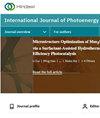Thermal Performance of a Dimpled Tube Parabolic Trough Solar Collector (PTSC) with SiO2 Nanofluid
IF 2.1
4区 工程技术
Q3 CHEMISTRY, PHYSICAL
引用次数: 4
Abstract
In this research work, dimple texture tubes and silicon dioxide (SiO2) nanofluid were used to analyze the performance parameters of a solar water heater. For this purpose, SiO2 was mixed with deionized (DI) water using an ultrasonic dispersion device to prepare the nanofluids (SiO2/DI-H2O). The size of the nanoparticle was in the range of 10-15 nm. Different volume concentrations of the nanoparticles in the range of 0.1% to 0.5%, in steps of 0.1%, were chosen to prepare the nanofluids to carry out the experiments. Apart from this, computational fluid dynamics (CFD) tool was used to numerically analyze the parameters affecting the performance of the solar water heater, as well as the fluid flow pattern in the dimple texture tube. During the experiment, the mass flow rate of the base fluid (water) varied in the range of 0.5 kg/min to 3.0 kg/min in steps of 0.5 kg/min. The added advantage of the dimple texture tube design led to an increase in turbulence in the flow pattern, resulting 34.2% increase in the convective heat transfer efficiency compared with the plain tube. Among all experimental modules, SiO2/DI-H2O with a mass flow rate of 2.5 kg/min and 0.3% volume concentration gives overall optimized results in absolute energy absorption, gradient temperature, and efficiency of the solar water heater. The efficiency metrics of the experimental results were compared with the simulation results, and it was in the acceptable range with an overall deviation of ±7.42%.含SiO2纳米流体的波纹管抛物槽太阳能集热器(PTSC)的热性能
在这项研究工作中,使用凹坑纹理管和二氧化硅(SiO2)纳米流体来分析太阳能热水器的性能参数。为此,使用超声分散装置将SiO2与去离子(DI)水混合以制备纳米流体(SiO2/DI-H2O)。纳米颗粒的尺寸在10-15的范围内 nm。选择0.1%至0.5%范围内的不同体积浓度的纳米颗粒,以0.1%的步骤制备纳米流体以进行实验。除此之外,还使用计算流体动力学(CFD)工具对影响太阳能热水器性能的参数以及凹坑纹理管中的流体流动模式进行了数值分析。在实验过程中,基础流体(水)的质量流速在0.5的范围内变化 kg/min至3.0 kg/min,步长为0.5 千克/分钟。凹坑纹理管设计的额外优势导致流型中的湍流增加,与普通管相比,对流传热效率提高了34.2%。在所有实验模块中,质量流量为2.5的SiO2/DI-H2O kg/min和0.3%的体积浓度在太阳能热水器的绝对能量吸收、梯度温度和效率方面给出了总体优化结果。将实验结果的效率指标与模拟结果进行了比较,结果在可接受的范围内,总体偏差为±7.42%。
本文章由计算机程序翻译,如有差异,请以英文原文为准。
求助全文
约1分钟内获得全文
求助全文
来源期刊
CiteScore
6.00
自引率
3.10%
发文量
128
审稿时长
3.6 months
期刊介绍:
International Journal of Photoenergy is a peer-reviewed, open access journal that publishes original research articles as well as review articles in all areas of photoenergy. The journal consolidates research activities in photochemistry and solar energy utilization into a single and unique forum for discussing and sharing knowledge.
The journal covers the following topics and applications:
- Photocatalysis
- Photostability and Toxicity of Drugs and UV-Photoprotection
- Solar Energy
- Artificial Light Harvesting Systems
- Photomedicine
- Photo Nanosystems
- Nano Tools for Solar Energy and Photochemistry
- Solar Chemistry
- Photochromism
- Organic Light-Emitting Diodes
- PV Systems
- Nano Structured Solar Cells

 求助内容:
求助内容: 应助结果提醒方式:
应助结果提醒方式:


